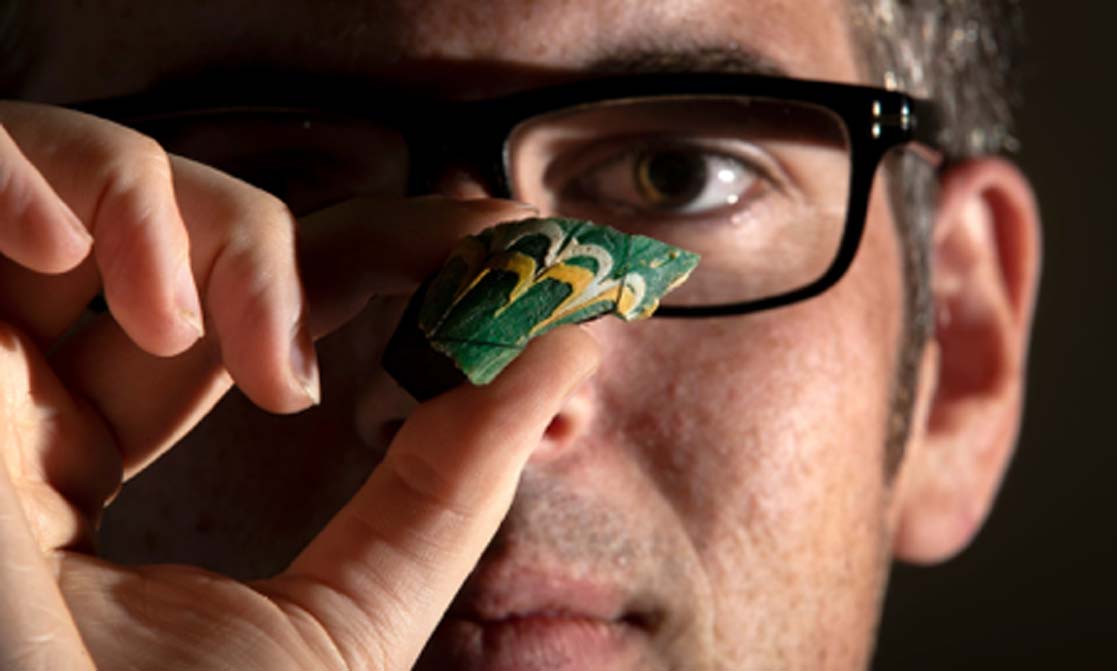1800-year-old Shard of Roman Glass Left A Fishy Trail From the Black Sea
The mystery of the origin of an unusual piece of glass has been solved in Britain. It has been established that it belonged to a very rare fish-shaped bottle, that came all the way from the Black Sea to a villa in southern England during the Roman Empire.
The Extravagate Roman Villa
This fragment of glass found at the site of a villa is demonstrating the affluence of the elite in Roman Britain. It is also indicating that long-distance trade networks crisscrossed the empire at its peak.
The find was made near the ruins of the Roman era Chedworth Villa, in Gloucestershire, England.
This is the largest villa ever found in the country and has yielded a treasure trove of archaeological items and mosaics, since the 19 th century.

Reconstruction of the Chedworth Roman Villa in the 4 th century where the Roman glass was discovered. (Rdacey / CC BY-SA 4.0)
In 2017, a team of archaeologists, from the National Trust led by Nancy Grace, were working on the Roman site. During the dig, Peter Moore, an archaeologist and graduate student from the University of York unearthed a very beautiful and unusual piece of glass. He told The Guardian that he realized “straight away it was something special”.
Mysterious Green Glass
The fragment was very unique but none of the team could say what type of glassware it came from. An initial assessment indicated that nothing like it has ever been found in Britain. The Guardian reports that the unusual piece was a “small shard of patterned green glass”.
A decision was taken to enlist the help of an authority on Roman glass and it was sent to Professor Jennifer Price, a world-renowned expert. She asked for assistance from colleagues around the world in order to identify the origin of the glass.
Price with the help of her colleagues was able to determine from the profile of the fragment that “it came from a long bottle with an oval shape and a sharp taper at the end” reports Heritage Daily. However, it was only when Professor Price compared the shard to a recently restored Roman bottle, that the mystery was solved. The BBC reports that the “fragment was found to match a fish-shaped bottle that had been restored from many pieces, at the Corning Museum of Glass in New York”.
- 1600–Year-Old Glass Workshop Discovered in Israel
- Romans Mastered Nanotechnology and Used it for Eye Catching Decoration
- Villa de Toralla: Who Lived in This Luxury High-Tech Roman Villa on the Galician Coast?

The fragment of Roman glass above an artist’s impression of how the fish bottle would have looked. (National Trust Images / Rod Kirkpatrick)
As a result, it is believed that the fragment was from of an 1800-year bottle. It was a flask like container and the opening of the bottle was styled to represent a fish’s mouth. The object was probably manufactured in Crimea, where the Romans had a client kingdom.
Heritage Daily reports that “the only other example of such a fish-shaped Roman bottle comes from a 2nd-century burial in Crimea”. The original fish-shaped bottle was produced by master craft persons and it made its way from the Black Sea to England, during the 1st century AD.
Roman Trade in Luxury Goods
The fish-shaped glassware, most likely contained some luxury product, probably perfume or some ointment. The small fragment of green glass demonstrates the wealth and sophistication of those who lived at Chedworth Villa. They were wealthy enough to purchase items from the other side of the Roman world.

The elite Romano-British imported luxury goods and decorated their villas with mosaics. (Pasicles / Public Domain)
That a glass bottle could be transported across the continent shows the sophistication of Roman merchants. It also shows that the imperial authorities were able to impose law and order over a vast area, which was essential for long-distance trade.
Sadly, the lady who worked for almost two years to solve the mystery of the glass did not live to see her efforts recognized. Professor Price passed away last May. She hugely enjoyed working on the object and solving the puzzle. Her research, on the beautiful shard, was recently published in Glass News.
The fragment is going on display at the villa as part of the Festival of Archaeology (until 28 July) and will remain on display throughout summer. For opening times and further information about Chedworth Roman Villa visit www.nationaltrust.org.uk/chedworth.
Top image: The fragment from the Roman fish bottle, the only one of its type ever discovered in Britain. Source: National Trust Images / Rod Kirkpatrick
By Ed Whelan



















